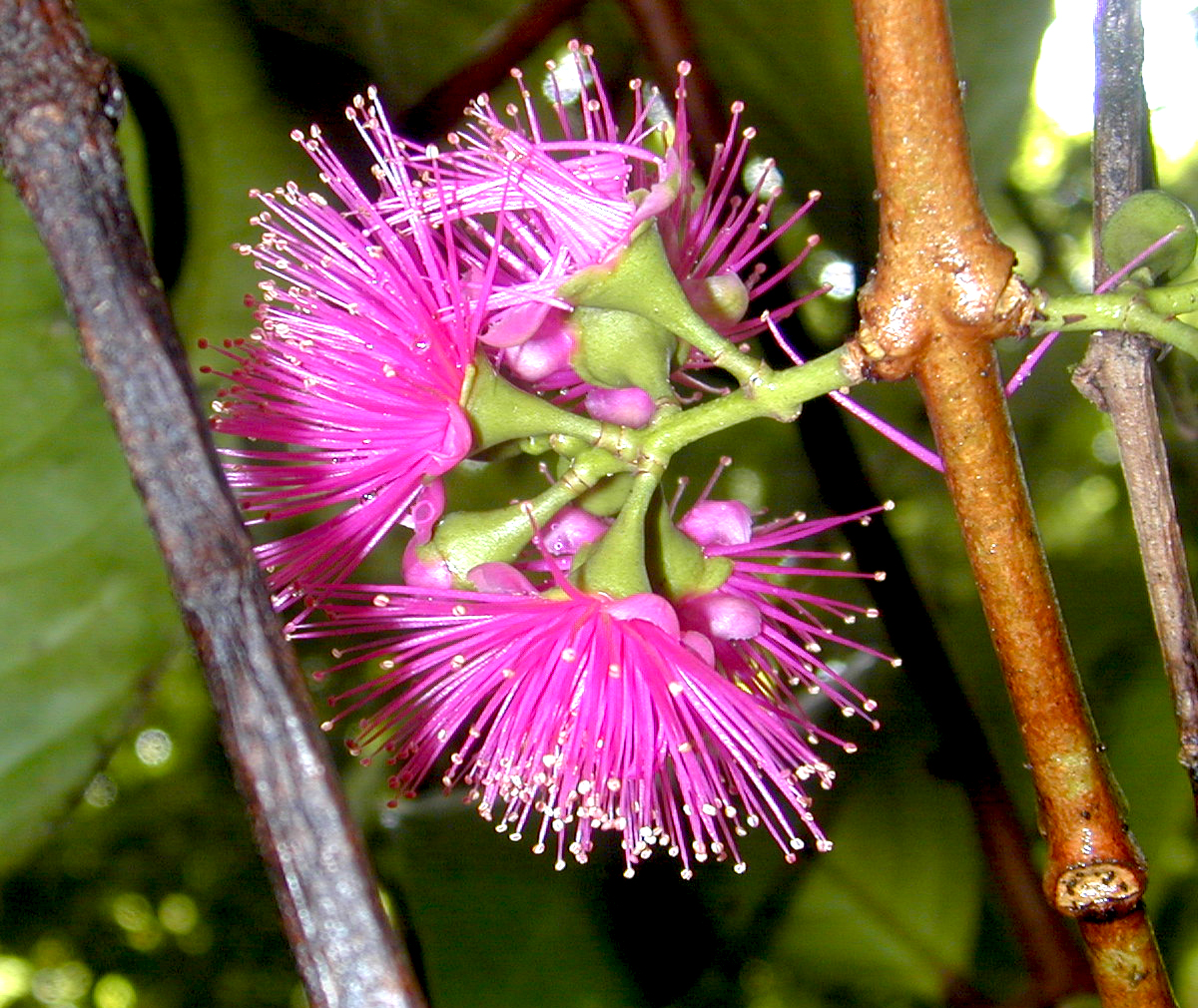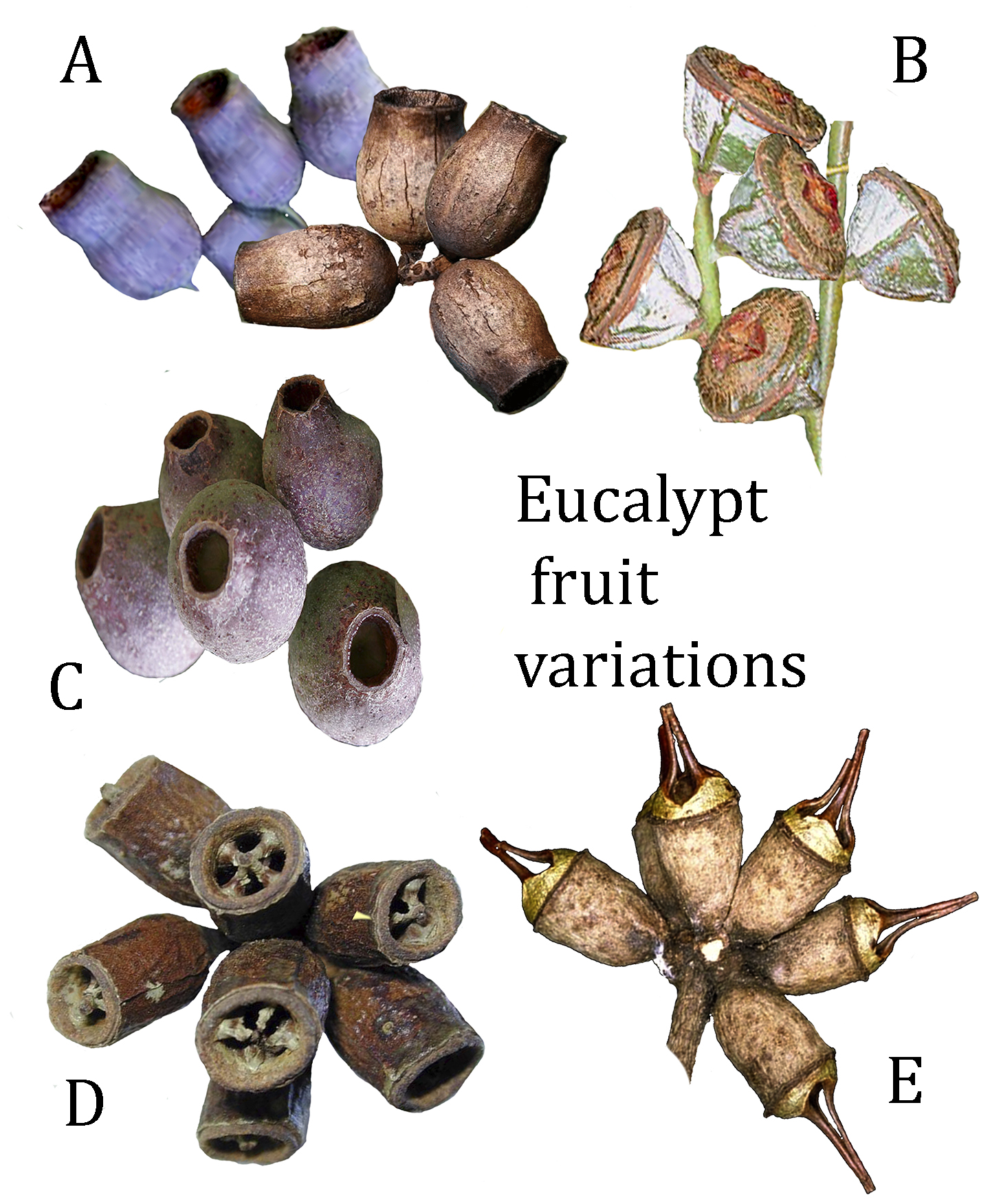|
|
||||||||
CPIE MultiAccess Key (MAK):
Trees of Hawai‘i – Family MYRTACEAEto MAK homepage.
|
 |
‘ohi‘a ‘ai (Syzigiuum malaccense) flowers. Stamen filaments number around 200 per flower |
||||||
|
|
||||||||
|
Trees classified in the Family Myrtaceae are numerous in Hawai‘i, comprising many common trees—Psidium (guavas) and Syzigium (Java plum, mountain apple [see photo above])—forest restoration trees—Eucalyptus spp., Corymbia spp.)—and several prominant native species—‘ōhi‘a lehua, for example. While many of these these trees are included in the Mak_trees key, the eucalypts alone are represented by 30+ species, many planted extensively in disturbed forests on all the main islands. Thus, the need to consider greater detail in characteristics to distinguish between species. The "MAK_6" DB presently contains 60 taxa of eudicot trees that are placed in the Family Myrtaceae—essentially all the introduced and native Myrtaceae reported from the Hawaiian Islands that have a tree form. Some of the planted ornamentals might be encountered as large shrubs.
Basic characteristics that members of the Family Myrtaceae have in common are: leaves coriaceous or leathery, opposite in the Subfamily Myrtoideae (Eugenia, Psidium, Syzigium), alternate or opposite in the Subfaily Leptospermoideae (Eucalyptus, Meleleuca, Metrosideros); stipules vestigial or absent; flowers with a well-developed hypanthium surrounding the ovary, and numerous filamentous stamens (male flower parts; see photo above). In many cases, encountering a tall unknown tree presents only a good look at the bark and the general form of the tree as seen from a distance. Searching the ground around a tree can provide leaf shape and sometimes fallen flowers or fruit if these are just too high to reach for examination. A multiaccess key attempts to overcome these limitations, providing a list of potential species names from whatever information can be provided. Thus, emphasis is put on the bark type and leaf characteristics as most useful in narrowing the list of potential matches. |
DATABASE: MAK_6 TOTAL DB TAXA: 60 (60 LINES) |
|||||||
|
SPECIAL NOTE ON EUCALYPTS—Because over 30 species of eucalypts are included in the MAK_6 data base, understanding the potential variability in this group is important. In some species of eucalypts, the shape of the leaf changes as the tree ages, typically from ovate (or even round) to linear. The bark of the lower trunk may be very different from that of the branches, and also may change as the trunk girth increases. SELECTED CHARACTER MATCH |
||||||||
|
Species - Common Name
|
Status SubFamily
|
Reference List
|
||||||
|
ISLAND: Because many eucalypts occur as a result of state forest replanting projects and different species were utilized in different forest reserve areas, it can be useful to indicate the island for the species ID being attempted. Not selecting an island will remove this "characteristic" from consideration in making a match. Distribution data are from Imada (2019) for naturalized species, and Wagner et al., (1990) for native trees. FORM: By tree "form" is meant the general shape of the tree, as expressed by the growth of the branches off the trunk. Most trees tend to an oval or rounded shape, although the vase shape is very common. In vase-shaped, the main branches grow up and out. In a spreading form, the main lateral branches tend to spread widely outwards creating an umbrella shape. In a columnar form, the branches are all short relative to the trunk. The forms intergrade and the shape a tree takes can depend on a number of factors so this characteristic is loosely applied in the key. BARK TYPE: Tree bark types are illustrated in a series of photographs at MAK Barks Illustrated, In the field, the type or form of the bark should be viewed on the lower part of the trunk and on the oldest specimen present. Younger trees may have more or less smooth or finely grooved bark that will mature over time into a more complex type. LEAF - ARRANGEMENT: Leaf arrangement describes how the leaves are borne on the stem (either alternating or in pairs, opposite each other along the stem; sometimes both arrangements can be present) and whether leaves are simple or compound *. Compound leaves are divided into leaflets and these can range in number from 2 to many per leaf. Leaflets may or may not be opposite on the rachis. Compound odd means the number of leaflets is an odd number: leaflets are paired, with one additional at tip of leaf. Compound even has all leaflets paired. LEAF - SHAPE: The shape and characteristics of a leaf can be described in many ways. To simplify, this MAK key considers only the most basic of shapes: the leaf is either narrow (linear), ovate, or broad (nearly as wide or wider than long); the tip of the leaf is either pointed (acute) or rounded (blunt). Basic shape can be applied to leaflets of compound leaves. LEAF - DETAILS: Special leaf characteristics to be noted are a distinct odor (aromatic) detected by smelling a crushed leaf; curved blade shape (falcate); discolorous = the underside of leaf is distinctly different in color from the upper surface; peltate = the leaf stem (petiole) attaches to the blade inside the blade margin. Because these are very distinct characteristics, selecting one will eliminate species lacking the characteristic.. INFLORESCENCE: Flowers are important structures to aid in identifying a particular tree, but often the tree is encountered outside its flowering period or the flowers are too high up to observe. In the Myrtaceae, the infloresence most typically is an umbellate cluster or paniculate and found at the tips of branches (tereminal) or in the axils of the leaves. FLOWER: Although flower colors cover a wide range, our Myrtaceae derive their overall color from the masss of stamens and these are either white, cream, or red. FRUIT: The fruit borne on a tree can be an exceptionally good characteristic for identifying the plant. In the Myrtaceae, two easily distinguished fruit types are found: a dry capsule (Subfamily Leptospermoideae) and a fleshy berry (Subfamily Myrtoideae). Fleshy fruits are usually edible and likely familiar. The woody fruits of the eucalypts are recognizable and additional characteristics can be applied to further differentiate between species. CAPSULE FRUIT DETAILS: For the eucalypts, the fruit capsule may be collected from the ground around the tree in order to observe details—Click HERE for an image showing the parts of a Leptospermoideae fruit.
|
Select tree characteristics from far left column. == Results will appear here ==
NOTES: The TERMINOLOGY used in this key may not always match exactly that used by botanists, being adapted here to make this key more accessible to the casual user. Read the paragraphs presented on this page in column to left to find definitions for terms used here to describe trees. CONFIRMING AN IDENTIFICATION will require careful consideration of the species description provided in the reference link or some other source (see References for other suggestions). "MAN" refers to Vols 1 & 2 of Manual of the Flowering Plants of Hawai‘i by Wagner, Herbst, and Sohmer; "S&H" refers to A Tropical Garden Flora by Staples and Herbst. A number in brackets indicates that a photo or drawing is provided in the referenced source (gives plate number in the Manual). These reference sources are known to provide a species description (and figure) on the page indicated. However, the casual user may find that a search of the internet for each of the taxa on the short list of possible identifications can provide a clinching photo or species decription, and is a logical next step whether one or several species are listed. A potentially useful approach is a short key based on bark typs provided by CTAHR. STATUS CODES presented are as follows: "End" = an endemic species; "Ind" = an indigenous species; "Nat" = a naturalized species; "Pol" = an early Poynesian introduction ("canoe plant"); and "Orn" = an ornamental species, not naturalized. A question mark should be read as "possibly".
A. Urn-shaped fruit of Corymbia calophylla and C. cladophora; B. Funnel-shaped fruits of Eucalyptus globulus; C. Globular or spherical fruits of Corymbia sp.; D. Cylindrical fruit of Eucalyptus robustus; E. Cylindrical fruits of Eucalyptus cornuta with extended valves; Figures modified from: (A) Ritter, 2014; Noel D. Preece; (B) Monaco Nature Encyclopedia; (C) Fir0002/Flagstaffotos at Wikimedia Commons; (D) Forest and Kim Starr; (E) CANBR, 2020. |
|
||||||
